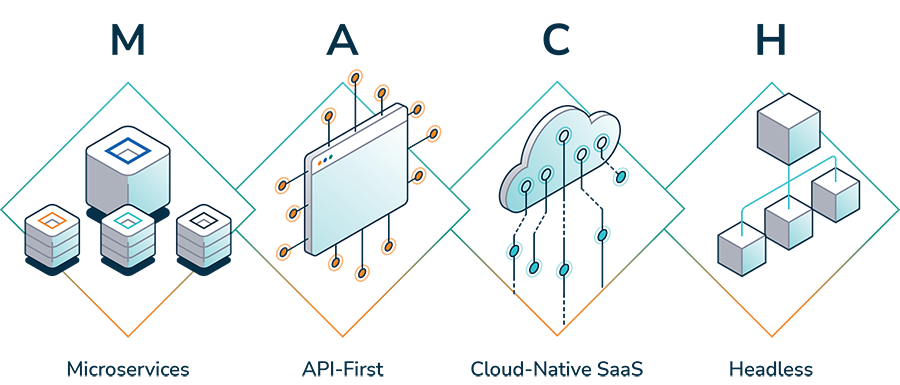Earlier this year, we published The Future Ready Asset Finance Platform, a research study that questioned asset finance leaders on the technology infrastructures at the heart of their operations. In gathering their thoughts, we learned a lot – not least that most say an almost foundational change is needed in terms of the core capabilities of those platforms.
While opinions on what exactly future asset finance platforms need to deliver was varied, most of our respondents did unite around a few key themes. Next-generation platforms must be connected and agile, they told us, offering broad functionality via seamless integration. They should prioritise elegant and effective user journeys, we heard. And, perhaps more than anything, they need to be effortlessly adaptable to changing needs.
When looking back at that research today, it’s difficult to do so without at least some consideration of the principles of MACH architecture in mind. For everything our participants said they expect to see in tomorrow’s asset finance platforms, Microservices-based, API-first, Cloud-native, and Headless (MACH) systems hold at least some of the answers.
If you’re unfamiliar with MACH as a concept – and rest assured that you won’t be alone – it’s a modern approach to infrastructure that focuses on the scalability, substitutability, and ongoing optimisation of individual components within a technology platform. MACH principles were pioneered in the field of e-commerce but have been gradually making their way into other industries, financial services included.
There are a wide range of benefits to MACH architectures, some of which I’ll touch on momentarily. For now, though, let’s take a quick look at the four underlying terms that provide us with that catchy acronym.
Microservices
While there’s some debate about the precise definition of a microservice (some are decidedly macro in their nature), their most important qualities are independent resiliency and scalability, optimising business functions while being more easily modified or substituted. By way of an example, a financial institution that wanted to make changes to its accounts receivable service could do so without worrying about the onward impact on its accounts payable or asset management services.
API-first
In an API-first system, all the data and functionality sitting within it can be accessed without touching the user interface. Not only is that critical from an automation perspective, but it also has major implications in terms of agility and flexibility. Specifically, API-first means that financial institutions can tap into data and functionality, without needing software vendor support, to meet new or previously unforeseen use cases.
Cloud-native
Theoretically, any legacy system can be put into the cloud. The problem is that almost none of the advantages of doing so can be realised automatically – benefits like elastic search capabilities, automated multi-site disaster recovery, service resiliency, automated capacity scaling, real-time mirrored data, automated deployment, inherent resiliency, upgrades, tight cost controls and more. Cloud-native systems, on the other hand, can capitalise on all those opportunities including the best-in-class tools and services that have been developed by the leading cloud vendors.
Headless
In a Headless system, the back and frontend of the platform are decoupled. That’s useful because it empowers an environment in which multiple user journeys can exist, supported by one system. As well as allowing the creation of entirely unique user experiences, that means that customer relationships can start anywhere a Headless system can reach – a broker or independent website, for example – and potentially be picked up and continued in another channel.

If I had to summarise what MACH offers, I might describe it as “choice without consequence”. It’s a modular and agile philosophy that prioritises best fit and best-of-breed over a rigid architectural model. Essentially, whatever you want or need to do, MACH can help you get there with less straining, breaking, or compromising of your overarching platform.
There are clear practical applications to this philosophy, too. Say that you need to train a group of new hires and bring them up to speed on your systems, for instance. Previously, that would have involved either an expensive, ongoing training instance, or the creation of a highly specific testing environment. The Cloud-native qualities of MACH makes that an almost “push button” activity.
Maybe you’re looking to conduct some experimental testing or reporting. Again, you would need to spin up a replica of your production database that offers the same real-time data access as the original – a potentially gigantic amount of work. Not only does MACH make that simple, but it does so while giving you a high degree of certainty about the outcomes, since it uses the same real-time data, software, and configuration as your actual production environment.
As a final example, imagine that you have an idea for a product that would meet the needs of an underserved audience or segment. The agile and compartmentalised nature of MACH means that you can rapidly develop, test, and launch that product – minimising time to customer and ensuring that you can capitalise on the currency of your concepts.
It is with all of this in mind that I’m pleased to say that with Lendscape Asset Finance, I believe we have delivered the world’s first true MACH architected asset finance platform.
As long-term believers in the transformational value that technology can bring to the asset finance industry, we’re excited to be leading the charge (at MACH speed!) towards a modern – and modular – future.
Author: Todd Sproule, Principle Developer
Editor: Iain Gomersall